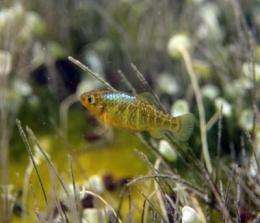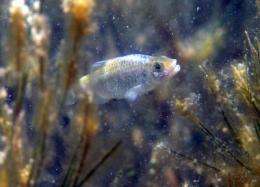A snapshot of pupfish evolution in action

Chris Martin has bred more than 3,000 hybrid fish in his time as a graduate student in evolution and ecology at UC Davis, a pursuit that has helped him create one of the most comprehensive snapshots of natural selection in the wild and demonstrated a key prediction in evolutionary biology.
"We can see a surprisingly complex snapshot of natural selection driving the evolution of new specialized species," said Martin, who with Professor Peter Wainwright published a paper on the topic in the Jan. 11, 2013, issue of the journal Science.
The "adaptive landscape" is very important for evolutionary biology, but rarely measured, Martin said. He's been fascinated with the concept since high school.
An adaptive landscape takes variable traits in an animal or plant, such as jaw size and shape, spreads them over a surface, and reveals peaks of success (what evolutionary scientists call fitness) where those traits become most effective, or adaptive.
It is a common and powerful idea that influences thinking about evolution. But while the concept is straightforward, it is much harder to map out such a landscape in the wild.
For example, about 50 species of pupfish are found across the Americas. The tiny fish, about an inch or so long, mostly eat algae on rocks and other detritus. Martin has been studying species found only in a few lakes on the island of San Salvador in the Bahamas, where some of the fish have evolved different-shaped jaws that allow them to feed on hard-shelled prey like snails or, in one case, to snatch scales off other fish.
In a paper published in 2011, Martin showed that these San Salvadoran fish are evolving at an explosively faster rate than other pupfish.

Martin brought some of the fish back to the lab at UC Davis and bred hybrids with fish with different types of jaws. He created about 3,000 hybrids in all, which were measured, photographed and tagged. Martin then took about 2,000 of the fish back to San Salvador.
"It was the craziest thing I've done," Martin said. "I was leaning on the stack of them in the middle of Miami airport."
Martin released the young fish into enclosures in the lakes of their grandparents. Three months later, he returned to check on the survivors and plotted them out on the adaptive landscape.
Most of the surviving fish were on an isolated peak adapted to a general style of feeding, with another peak representing fish adapted for eating hard-shelled prey. Competition between the fish had eliminated the fish whose jaws put them in the valleys between those peaks. The scale-eating fish did not survive.
The results explain why most pupfish species in America have pretty much the same diets, Martin said. The generalists are essentially stranded on their peak—variants that get too far out fall into the valley and die out before they can make it to another peak.
"It's stabilizing selection," he said. An early burst of variation when fish entered a new environment with little competition could have allowed the shell-eaters and scale-eaters to evolve on San Salvador.
More information: "Multiple Fitness Peaks on the Adaptive Landscape Drive Adaptive Radiation in the Wild," by C.H. Martin et al, Science, 2013.
Journal information: Science
Provided by UC Davis




















